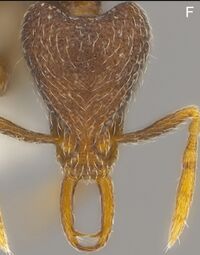Strumigenys parzival
| Strumigenys parzival | |
|---|---|

| |
| Scientific classification | |
| Kingdom: | Animalia |
| Phylum: | Arthropoda |
| Class: | Insecta |
| Order: | Hymenoptera |
| Family: | Formicidae |
| Subfamily: | Myrmicinae |
| Tribe: | Attini |
| Genus: | Strumigenys |
| Species: | S. parzival |
| Binomial name | |
| Strumigenys parzival Sarnat, Hita-Garcia, Dudley, Liu, Fischer & Economo, 2019 | |
Identification
Strumigenys parzival is a small dark reddish-brown species with flagellate apicoscrobal, humeral and basitarsal hairs, but is most recognizable by the uniform costulae that extend longitudinally across the entire first gastral tergite. The species is nearly identical to P. panaulax with respect to both pilosity patterns and the gastral sculpture. The two are so similar that Sarnat and Economo (2012) did not recognize S. parzival as a new species distinct from P. panaulax. Subsequent comparison with the type specimen of P. panaulax revealed discrete differences between the two species with respect to pronotal and petiolar sculpture. Whereas the pronotal dorsum and petiolar dorsum of P. panaulax are obliquely costulate-rugulose, those of P. parzival are longitudinally and irregularly rugoreticulate. Both these ants are similar to a cluster of species closely related to S. chernovi, and additional diagnostic notes are listed under the latter.
Distribution
Distribution based on Regional Taxon Lists
Indo-Australian Region: Fiji (type locality).
Distribution based on AntMaps
Distribution based on AntWeb specimens
Check data from AntWeb
Countries Occupied
| Number of countries occupied by this species based on AntWiki Regional Taxon Lists. In general, fewer countries occupied indicates a narrower range, while more countries indicates a more widespread species. |

|
Biology
Strumigenys parzival is known only from a single leaf litter collection of two workers on Vanua Levu.
Castes
 X-ray micro-CT scan 3D model of Strumigenys parzival (worker) prepared by the Economo lab at OIST.
X-ray micro-CT scan 3D model of Strumigenys parzival (worker) prepared by the Economo lab at OIST.
Sarnat et al. 2019. Holotype, Vanua Levu, Fiji. See on Sketchfab. See list of 3D images.
Nomenclature
The following information is derived from Barry Bolton's Online Catalogue of the Ants of the World.
- parzival. Strumigenys parzival Sarnat, Hita-Garcia, Dudley, Liu, Fischer & Economo, 2019: 39, figs. 8F, 10I, 10J, 22, 28, Model 6 (w.) FIJI.
Description
Worker. Measurements (n = 2): TL 2.10–2.24 mm, HL 0.51–0.54 mm, HW 0.39–0.40 mm, CI 74–77, MdL 0.23–0.24 mm, MI 45, SL 0.32–0.34 mm, SI 74–75, PW 0.24–0.25 mm, PI 60–63, FL 0.32–0.34 mm, FI 82–84, EL 0.24–0.25 mm. Color dull dark reddish-brown with yellowish-brown appendages. Color dark reddish-brown. Mandibles long and linear with one preapical tooth; preapical tooth length approximate to maximum mandible width. Apicoscrobal hair filiform to flagellate. Cephalic dorsum uniformly reticulate-punctate. Ground pilosity of cephalic dorsum short, simple, strongly curved. Pronotal humeral hairs flagellate. Pronotal dorsum longitudinally and irregularly rugoreticulate; mesonotum reticulate-punctate; propodeal dorsum and declivity polished smooth. Side of pronotum longitudinally costulate. Mesopleuron, metapleuron, and side of propodeum polished smooth. Pronotal dorsum with one pair and mesonotum with one to two pairs of erect flagellate hairs; ground pilosity long, curved, and flexous. Dorsal surface of hind tibia with at least one flagellate hair that is similar to that on the basitarsus. Propodeal tooth short, narrowly triangular. Propodeal lamella in profile with a straight to shallowly convex posterior margin. Petiolar node in profile evenly convex with similar anterior and posterior faces; lateral spongiform lobe small; restricted to posterior margin of node. Dorsum of petiole strongly reticulate-punctate. Postpetiolar disc weakly reticulate-punctate. Ventral lobe of postpetiole large, thin, and more lamellate than spongiform. Dorsum of petiolar node rugoreticulate; disc of postpetiole with closely spaced longitudinal costulae. First gastral tergite with closely spaced broad and uniform costulae that extend unbroken from base to apex. First gastral tergite with sparse erect flagellate hairs and long filiform pilosity.
References
- Sarnat, E.M., Hita-Garcia, F., Dudley, K., Liu, C., Fischer, G., Economo, E.P. 2019. Ready species one: Exploring the use of augmented reality to enhance systematic biology with a revision of Fijian Strumigenys (Hymenoptera: Formicidae). Insect Systematics and Diversity 3(6): 6; 1–43 (doi:10.1093/isd/ixz005).

